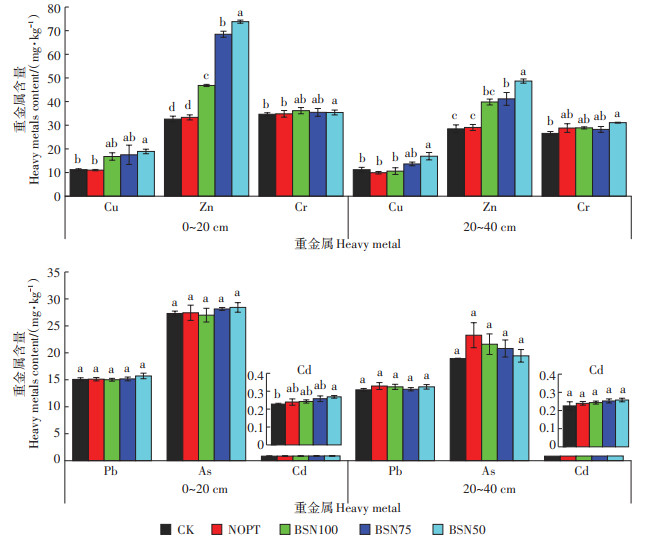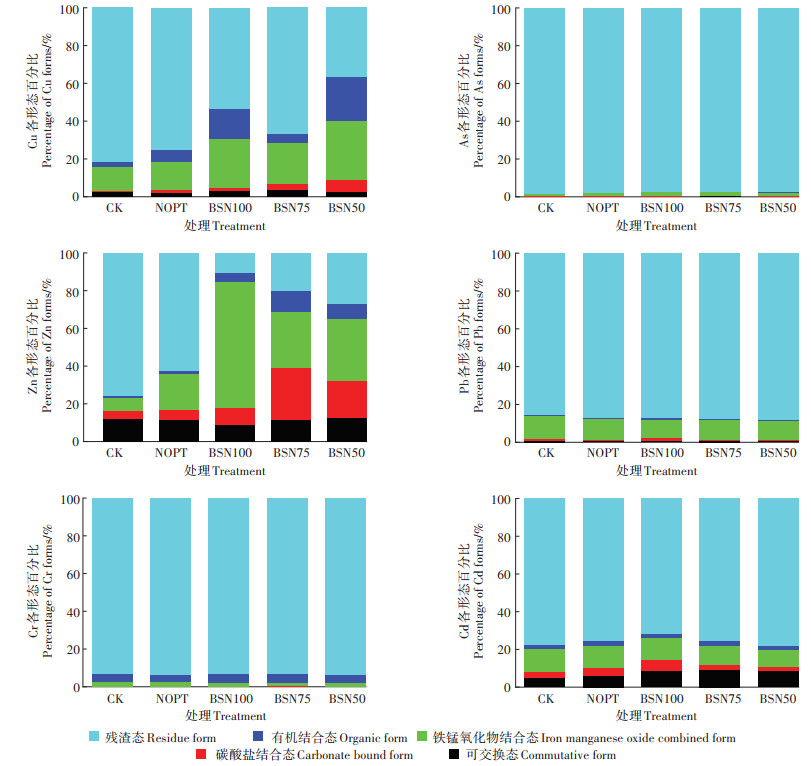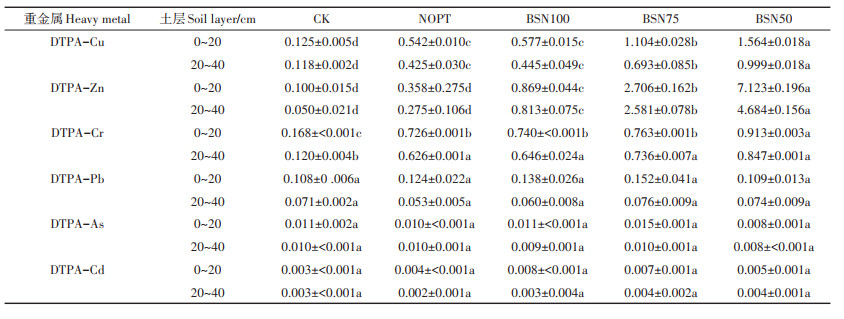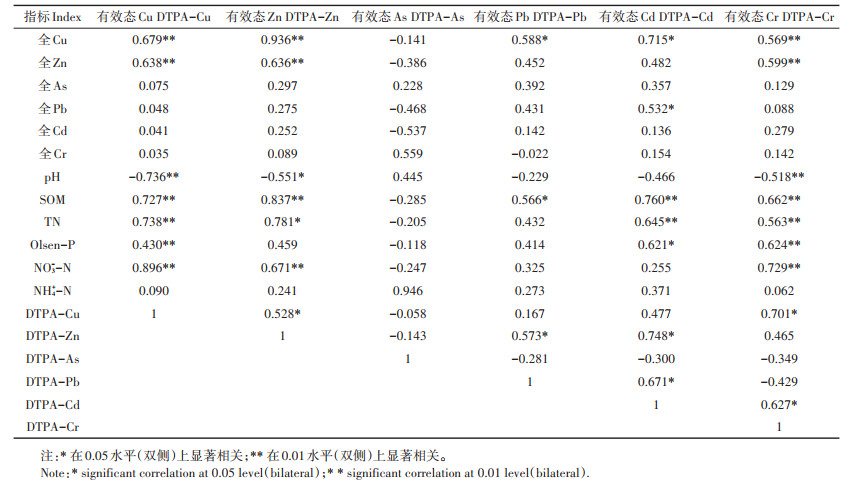2. 湖北省十堰市农业科学院, 湖北 十堰 442000
2. Shiyan Academy of Agricultural Science, Shiyan 442000, China
随着规模化畜禽养殖业的发展,畜禽废弃物不合理排放带来的环境污染问题日渐突出[1],第二次全国污染源普查显示,畜禽养殖业总氮排放量为59.6万t、总磷12.0万t。畜禽粪水中含有丰富的氮磷养分[2],施入农田后能够提高土壤有机质含量[3]、促进作物增产提质[4-5]。国家发布了系列政策性文件鼓励畜禽粪污处理后施用于农田[6-8]。种养结合循环发展是畜禽废弃物资源化利用的根本出路,也是破解农业面源污染难题、践行绿色发展理念的重要举措[9]。
与固体粪肥相比,解决液体粪水还田问题是种养结合的核心环节[10]。畜禽养殖粪水还田后对作物和土壤重金属的影响,一直是众多学者关注的重点。NICHOLSON等[11]和XIONG等[12]指出畜禽粪浆的施用已经成为农田土壤重金属污染的重要来源;CAO等[13]和SHI等[14]认为畜禽粪水施用是环境中重金属浓度增加的重要原因;QIAN等[15]进行了连续4年的猪粪施用田间试验并用模型估算表明,未来10~50a,中国农业土壤中Cd、Cu和Zn的环境风险将超过阈值水平,亟需确立合理的粪便施用量。刘洪恩等[16]的研究指出,养殖粪水施用造成土壤Cu和As的累积;靳省飞等[17]认为猪粪水施用后,植物对重金属的累积因土壤理化性质、土壤重金属种类不同而存在差异。粪水还田对作物和土壤重金属带来的潜在风险应得到重视。
丹江口水库是南水北调中线工程水源地,是我国规模最大的饮用水源保护区,化肥施用负荷较大[18],种养脱节,土壤质量下降,亟需建立养殖粪水农田施用的种养结合循环模式。当前的研究多围绕库区化肥施用负荷[18]和库区氮磷流失特征[19-21]等展开,库区典型种养结合对作物和土壤重金属的影响研究鲜见报道。因此,本文以设施白菜田间定位试验为例,设置不施肥处理、优化施肥处理和猪场粪水替代化肥5个处理,开展猪场粪水氮替代化肥氮对设施白菜和土壤重金属影响的研究,以期为该区域养殖粪水资源化利用及养殖业可持续发展提供科学依据。
1 材料与方法 1.1 试验设计试验地位于湖北省十堰市谭家湾镇,该地土壤为黄棕壤,种植前0~20cm土层土壤有机质含量6.58g· kg-1、pH7.72、全氮含量0.51g·kg-1、硝态氮含量40.60 mg·kg-1、铵态氮含量1.99mg·kg-1、速效磷含量36.91 mg·kg-1、Cd含量0.51mg·kg-1、As含量4.91mg·kg-1,Pb含量12.75mg·kg-1、Cr含量29.58mg·kg-1、Cu含量2.05mg·kg-1、Zn含量33.21mg·kg-1。
试验设置5个处理:对照处理(CK),不施用肥料;优化施肥处理(NOPT),底肥氮、磷、钾施用量分别为216、96、216kg·hm-2,白菜莲座期追肥分别为43、19、43kg·hm-2,结球期追肥分别为22、10、22kg·hm-2;猪场粪水氮全量替代化肥氮处理,粪水氮量分别为281、374、561kg·hm-2,记作BSN100、BSN75、BSN50,BSN100、BSN75、BSN50处理磷养分量与NOPT处理一致,BSN100、BSN75处理钾养分量与NOPT处理一致,粪水中不足的磷钾养分用化学肥料补齐。BSN50粪水钾养分量底肥时期施入296kg·hm-2,莲座期施入59kg·hm-2,结球期施入30kg·hm-2。试验用化肥为蔬菜专用肥(N-P2O5-K2O为18-8-18)、过磷酸钙(P2O5含量12%)和硫酸钾(K2O含量51%)。
试验用粪水为经过厌氧处理(6个月密闭贮存发酵)的猪粪水,粪水养分含量常年稳定,pH7.51、总氮含量773.00mg·L-1、铵态氮含量702.00mg·L-1、总磷含量19.10mg·L-1、总钾含量746.00mg·L-1,Cu含量0.55mg·L-1、Zn含量1.42mg·L-1、Cr含量50.00μg· L-1、Pb含量21.11μg·L-1、Cd含量1.51μg·L-1,As含量13.17μg·L-1。
试验于2017年10月开始,2019年12月结束,白菜株距35cm,行距40cm,连续种植4茬白菜。每个处理重复3次,小区面积6.72m2,随机区组排列,小区间用PVC板隔开。
1.2 样品采集与测定第4茬白菜收获后,选取代表性的植株,洗净后105℃杀青30min,70℃下烘干至恒质量,研磨过80目筛后保存待测。白菜样品地上部用HNO3消煮,电感耦合等离子体质谱仪(ICP-MS)测定Cu、Zn、Cr、Pb、As、Cd含量,采用植物标准物质(SRM-1570a)进行质量控制。
土壤样品在第4茬白菜收获后用土钻在每个小区按照“S”型分0~20cm和20~40cm两层采集,同层次5点混合放入塑料袋,带回实验室自然风干,研磨后过100目筛保存待测。采用HNO3-HF消解,ICPMS测定土壤中重金属Cu、Zn、Cr、Pb、As、Cd的全量,采用土壤标准物质(SRM-2586)进行质量控制。
采用Tessier五步连续提取法[22]测定土壤中Cd、Cr、Pb、Cu、Zn、As的形态分级,分别对可交换态、碳酸盐结合态、铁锰氧化物结合态、有机结合态和残渣态进行提取,重金属有效态用0.05mol·L-1EDTA提取,ICP-MS进行各形态测定。土壤pH和有机质(SOM)、全氮(TN)、铵态氮(NH+4-N)、硝态氮(NO-3-N)、速效磷(Olsen-P)含量按鲍士旦[23]的方法测定。
活化率为土壤重金属有效态含量占土壤重金属全量的比例[24]。
1.3 数据分析试验数据采用SPSS26软件进行单因素方差分析,Duncan多重比较法进行差异显著性检验,Excel 2016、Origin2021软件作图。
2 结果与分析 2.1 粪水施用对白菜地上部重金属含量的影响各处理白菜地上部重金属含量如表 1所示,随着施肥量增加,白菜地上部重金属的含量增加(As、Pb除外),且均高于不施肥处理。白菜地上部Cu、Zn含量变化规律一致,Cu、Zn含量NOPT处理和粪水施用处理(BSN100、BSN75、BSN50)显著高于CK处理(P < 0.05),BSN50处理显著高于BSN100处理和BSN75处理。白菜地上部Cr含量BSN50处理显著高于BSN75、BSN100及NOPT处理(P < 0.05),BSN75、BSN100和NOPT处理之间无显著差异。白菜地上部Pb、As含量NOPT处理高于粪水施用处理,且显著高于CK和BSN100处理。白菜地上部Cd含量随着施肥量增加而显著增加,呈BSN50>BSN75>BSN50、NOPT>CK。白菜地上部As、Pb、Cr、Cd含量均未超过《食品安全国家标准食品中污染物限量》(GB2762— 2017)安全限值要求。
|
|
表 1 白菜地上部重金属含量(mg·kg-1) Table 1 Contents of heavy metals in the ground of cabbage(mg·kg-1) |
由图 1可知,0~20cm土层土壤Cu、Zn、As、Pb、Cr、Cd含量高于20~40cm土层。各处理0~40cm土层土壤Cu含量为9.925~18.915mg·kg-1,BSN50处理高于其他处理,其他4个处理间差异不显著(P> 0.05)。0~20cm土层土壤Zn含量为32.601~73.820 mg·kg-1,粪水施用处理(BSN100、BSN75、BSN50)显著高于CK及NOPT处理,且随粪水施用量的增加而显著增加,20~40cm土层土壤Zn含量变化规律与0~20 cm土层一致。在0~20cm土层中,BSN50处理的土壤Cr含量显著高于NOPT处理,在20~40cm土层中粪水施用处理与NOPT处理无显著差异。各处理土壤Pb、As含量在0~40cm土层均无显著差异且未超过安全标准;土壤Cd含量为0.225~0.258mg·kg-1,0~40cm土层处理间(除0~20cm土层CK处理外)土壤Cd含量无显著差异。土壤Cu、Zn、Cr、Pb、As、Cd含量均未超过《土壤环境质量农用地土壤污染风险管控标准(试行)》(GB15618—2018)的安全限值。

|
不同小写字母表示处理间差异显著(P < 0.05) Different lowercase letters indicate significant difference among treatments(P < 0.05) 图 1 土壤重金属Cu、Zn、Cr、Pb、As、Cd含量 Figure 1 Contents of Cu, Zn, Cr, Pb, As and Cd in the soil |
粪水施用后土壤重金属有效态含量如表 2所示。粪水施用处理0~20cm土层土壤有效态Cu含量显著高于CK处理,且随粪水用量增加而显著增加,BSN100处理和NOPT处理无显著差异;20~40cm土层有效态Cu含量与0~20cm土层规律一致。粪水施用处理0~40cm土层土壤有效态Zn含量显著高于NOPT处理和CK处理,且随粪水用量增加而显著增加。土壤Cu、Zn活化率为8.26%和9.65%,远高于土壤As、Pb、Cd、Cr的活化率。
|
|
表 2 不同处理土壤重金属的有效态含量(mg·kg-1) Table 2 Available contents of heavy metals in different treatment soils(mg·kg-1) |
0~20cm土层土壤有效态Cr含量BSN50处理、CK处理和NOPT处理间差异达显著水平(P < 0.05),呈BSN50>NOPT>CK,且粪水施用处理间BSN50处理显著高于BSN100处理和BSN75处理;20~40cm土层土壤有效态Cr含量各施肥处理间无显著差异。0~40 cm土层土壤中有效态Pb、As、Cd含量5个处理之间均无显著差异。
2.4 粪水施用对土壤重金属形态分布特征的影响粪水施用后0~20cm土层土壤重金属形态分布如图 2所示,土壤Cu含量5个处理均以残渣态Cu为主,平均占比62.69%,残渣态Cu含量所占比例CK处理是施肥处理的1.09~2.22倍,说明施肥处理会降低残渣态Cu含量,且土壤中Cu形态分布具有显著差异性,呈现为残渣态>铁锰氧化物结合态>有机结合态>碳酸盐结合态、可交换态。土壤铁锰氧化物结合态Cu含量粪水施用处理显著高于NOPT处理和CK处理,相较于NOPT处理,粪水施用后有机结合态、碳酸盐结合态和可交换态Cu的含量略有增加。粪水施用后土壤有机结合态和碳酸盐结合态Zn含量略高于CK处理和NOPT处理。CK、NOPT处理以残渣态Zn为主,所占比例为62.26%~75.42%,显著高于粪水施用处理,粪水施用处理以铁锰氧化物结合态Zn为主,其含量占比为29.89%~66.71%,且铁锰氧化物结合态Zn占比显著高于NOPT处理和CK处理。粪水施用显著增加了铁锰氧化物结合态Zn的比例,降低了残渣态Zn的比例。

|
图 2 土壤重金属形态比较 Figure 2 The comparison of soil heavy metals forms |
粪水施用处理与NOPT处理土壤残渣态As、Cr含量占比在92%以上,显著高于可交换态、碳酸盐结合态、铁锰氧化物结合态及有机结合态As、Cr含量。各处理土壤Pb、Cd形态均以残渣态为主,其占比为71.76%~87.77%,显著高于其他4种形态,铁锰氧化物结合态比例次之,其比例显著高于碳酸盐结合态、有机结合态和可交换态的比例。施用粪水和化肥均不会引起土壤As、Cr、Cd、Pb形态的转移变化。
2.5 粪水施用后重金属有效态含量与全量、土壤理化性质的相关分析对土壤重金属有效性与土壤重金属全量、理化性质进行相关分析可知(表 3),土壤有效态Cu含量与全Cu、全Zn、SOM、TN、Olsen-P和NO-3-N含量呈极显著正相关,与pH呈极显著负相关;有效态Zn含量与全Cu、全Zn、SOM、TN、NO-3-N、有效态Cu呈显著或极显著正相关,与pH呈显著负相关;有效态Pb含量与全Cu、SOM、有效态Zn含量呈显著正相关;有效态Cd含量与全Cu、全Pb、SOM、TN、Olsen-P、有效态Zn、有效态Pb呈显著或极显著正相关;有效态Cr含量与全Cu、全Zn、SOM、TN、Olsen-P、NO-3-N均呈极显著正相关,与pH呈极显著负相关,与有效态Cu、有效态Cd呈显著正相关。有效态As含量与其他指标相关性均不显著。
|
|
表 3 重金属有效态含量与土壤理化性质、重金属全量的Pearson相关系数 Table 3 Pearson correlation coefficients of heavy metals contents and physical and chemical properties |
粪水中富含的养分能够促进植物生长,但粪水施用后可能会引起土壤和植物重金属超标[25]。粪水施用于设施白菜后,相较CK处理,粪水施用(BSN100、BSN75、BSN50)处理白菜增产量均达到显著水平(P < 0.05),相较NOPT处理,粪水施用处理组4茬白菜增产率达13.73%~39.45%,粪水带入氮具有显著的增产效果[26]。本研究中4茬粪水施用后白菜地上部重金属含量均未超过《食品安全国家标准食品中污染物限量》(GB2762—2017)的安全限值要求。BIAN等[27]研究了粪水施用于水稻、小麦和大白菜等作物,提出施用粪水会增加植物重金属的含量,蔬菜具有不同的重金属转移能力,叶类蔬菜比非叶类蔬菜对重金属的吸收更强,CAO等[13]的研究也指出叶菜更易发生重金属的累积超标。另外,土壤性质的变化对叶菜类蔬菜的重金属积累影响也较大[28]。本研究粪水施用后白菜地上部重金属Cu、Zn、Cr、Cd含量显著高于CK处理,粪水施用显著增加了白菜地上部Cu、Zn、Cr、Cd的含量,但4茬粪水施用未引起白菜地上部重金属的超标,长期施用的影响需进一步研究。黄新灿等[29]认为长期施用猪粪肥源可显著增加蔬菜中重金属的积累,应避免连续长期施用富含Cu、Zn等重金属的畜禽粪肥。罗伟等[30]的研究证实沼液施用对马铃薯中重金属污染影响不明显,可安全利用;赵麒淋等[31]的研究表明,施用沼液后未导致玉米籽粒中重金属积累超过国家标准,但与不施肥处理相比,Cd、Cr含量略有增加,这与本研究结果相一致。长期施用沼液对土壤和作物重金属含量的影响仍需进一步探究。
3.2 影响土壤有效态重金属的因素有效态重金属是指可以被动植物等生物体吸收利用的金属形态。pH值[32]、SOM等会影响土壤中重金属的有效性[33-34]。pH是降低重金属有效性的重要因子[35-36],pH增加可使土壤胶体吸附重金属离子的能力增强,从而使重金属有效态含量降低[37];SOM是影响重金属有效性的另一关键因子,SOM含量增加,从而可通过络合及螯合作用来促进重金属生物可利用性的提高[38-39]。WU等[40]研究表明稻田土壤有效态Cu与SOM存在极显著相关性;ZHAO等[41]研究证实重金属有效性与SOM含量呈显著正相关。本研究中有效态Cu、Zn、Pb、Cd和Cr含量与SOM呈显著正相关,与ZHAO的研究结果一致;粪水施用提高了土壤pH,但土壤Pb、As、Cd有效态含量无显著变化,而土壤Cu、Zn、Cr有效态含量增加,这与上述研究结果不一致,可能是其他因素导致了土壤Cu、Zn、Cr有效态含量的增加。长期施用粪水需考虑重金属活性增强逐渐产生的污染。
3.3 影响土壤重金属形态的因素重金属不同化学形态关系到重金属元素的迁移转换能力,进而决定着元素的生物有效性和对生态环境的危害程度[42]。杨凤等[43]指出可交换态重金属易被作物吸收,因此对作物危害也最大;碳酸盐结合态重金属易受土壤理化性质(pH)及其他环境条件的影响;铁锰氧化物结合态重金属能在较低的氧化还原电位条件下被还原,对土壤存在潜在危害;有机物及硫化物结合态重金属较稳定;残渣态重金属性质稳定,不易被作物利用[44]。商和平等[45]指出,一方面施肥影响土壤的pH等理化性质进而影响重金属的形态,另一方面受施肥本身各形态的重金属和有机质影响而发生化学反应影响其形态。本研究中受粪水施用的影响,土壤残渣态Cu、Zn含量显著降低,土壤Cu、Zn以铁锰氧化物结合态为主,与上述研究结果一致;粪水施用后铁锰氧化物结合态Cu、Zn占比为32.66%~ 66.71%,可能是由于猪场粪水施用带入的Cu和Zn转化为了铁锰氧化物结合态,从而引起土壤Cu、Zn铁锰氧化物结合态占比增高。长期施用粪水要警惕其氧化还原对土壤Cu、Zn的潜在危害。
4 结论(1)连续4茬白菜种植后,粪水施用处理白菜地上部Cu、Zn、Cr、Cd含量较不施肥处理显著增加,相较于优化施肥处理,高量粪水施用处理显著增加了白菜地上部Cu、Zn、Cr、Cd含量,但均未超过《食品安全国家标准食品中污染物限量》(GB2762—2017)的安全限值要求。白菜地上部Cu、Zn、Cr、Cd含量低量施肥处理与优化施肥处理间无显著差异。
(2)相较于优化施肥处理,高量粪水施用处理显著增加了土壤Cu、Zn、Cr含量;土壤Cu、Zn(0~20cm土层除外)、Pb、Cr、Cd、As含量低量粪水施用处理与优化施肥处理间无显著差异。0~20cm土层Cu、Zn、As、Cr、Cd、Pb含量高于20~40cm土层,土壤重金属含量由表层向下层逐渐降低。
(3)施用化肥和粪水显著提高了土壤有效态Cu、Zn含量,降低了残渣态Cu、Zn含量,增强了土壤Cu、Zn的活性,粪水施用显著增加了铁锰氧化物结合态Zn含量,施用化肥和粪水均不会引起土壤Cr、As、Cd、Pb形态的转移变化。土壤有效态Cu、Zn、Cr、Cd、Pb含量与土壤SOM、Olsen-P、TN、NO-3-N存在显著正相关关系,与pH呈显著负相关关系。
| [1] |
吴根义, 廖新俤, 贺德春, 等. 我国畜禽养殖污染防治现状及对策[J]. 农业环境科学学报, 2014, 33(7): 1261-1264. WU G Y, LIAO X D, HE D C, et al. Current situation and countermeasures of livestock industry pollution control in China[J]. Journal of Agro-Environment Science, 2014, 33(7): 1261-1264. |
| [2] |
武淑霞, 刘宏斌, 黄宏坤, 等. 我国畜禽养殖粪污产生量及其资源化分析[J]. 中国工程科学, 2018, 20(5): 103-111. WU S X, LIU H B, HUANG H K, et al. Analysis on the amount and utilization of manure in livestock and poultry breeding in China[J]. Strategic Study of CAE, 2018, 20(5): 103-111. |
| [3] |
YAN X Y, GONG W. The role of chemical and organic fertilizers on yield, yield variability and carbon sequestration: Results of a 19-year experiment[J]. Plant & Soil, 2010, 331(1/2): 471-480. |
| [4] |
李硕, 王选, 张西群, 等. 猪场肥水施用对玉米-小麦农田氨排放、氮素利用与表观平衡的影响[J]. 中国生态农业学报, 2019, 27(10): 1502-1514. LI S, WANG X, ZHANG X Q, et al. Effects of swine slurry application on ammonia emission, nitrogen utilization and apparent balance of a winter wheat-summer maize rotation system[J]. Chinese Journal of Eco-Agriculture, 2019, 27(10): 1502-1514. |
| [5] |
杜会英, 冯洁, 郭海刚, 等. 麦季牛场肥水灌溉对冬小麦-夏玉米轮作土壤氮素平衡的影响[J]. 农业工程学报, 2015, 31(3): 159-165. DU H Y, FENG J, GUO H G, et al. Effects of dairy effluents irrigation on N balance in soil under winter wheat-summer maize rotation system[J]. Transactions of the Chinese Society of Agricultural Engineering, 2015, 31(3): 159-165. DOI:10.3969/j.issn.1002-6819.2015.03.022 |
| [6] |
农业农村部办公厅, 财政部办公厅. 关于开展绿色种养循环农业试点工作的通知[EB/OL]. (2021-05-26)[2021-09-14]. http://www.moa.gov.cn/xw/bmdt/202105/t20210526_6368443.htm. General Office of the Ministry of Agriculture and Rural Affairs, General Office of the Ministry of Finance. Notice on the pilot program of green planting and feeding circular agriculture[EB/OL]. (2021-05-26)[2021-09-14]. http://www.moa.gov.cn/xw/bmdt/202105/t20210526_6368443.htm. |
| [7] |
农业农村部办公厅. 畜禽粪污土地承载力测算技术指南[EB/OL]. (2018-01-22)[2021-09-14]. http://www.moa.gov.cn/gk/tzgg_1/tfw/201801/t20180122_6135486.htm. General Office of the Ministry of Agriculture and Rural Affairs. Technical guidelines for estimating land carrying capacity of livestock and poultry manure[EB/OL](2018-01-22)[2021-09-14]. http://www.moa.gov.cn/gk/tzgg_1/tfw/201801/t20180122_6135486.htm. |
| [8] |
农业农村部办公厅, 生态环境部办公厅. 关于进一步明确畜禽粪污还田利用要求强化养殖污染监管的通知[EB/OL](2021-06-04)[2021-09-14]. http://www.gov.cn/zhengce/zhengceku/2020-06/20/content_5520767.htm. General Office of the Ministry of Agriculture and Rural Affairs, General Office of the Ministry of Ecology and Environment. On further clarifying the requirements of returning livestock and poultry manure to the field and strengthening the supervision of breeding pollution[EB/OL](2021-06-04)[2021-09-14]. http://www.gov.cn/zhengce/zhengceku/2020-06/20/content_5520767.htm. |
| [9] |
董红敏, 左玲玲, 魏莎, 等. 建立畜禽废弃物养分管理制度促进种养结合绿色发展[J]. 中国科学院院刊, 2019, 34(2): 180-189. DONG H M, ZUO L L, WEI S, et al. Establish a nutrient management system for livestock and poultry waste to promote green development in combination with planting and breeding[J]. Bulletin of Chinese Academy of Sciences, 2019, 34(2): 180-189. |
| [10] |
赵润, 杨仁杰, 牟美睿, 等. 基于中红外光谱的规模化奶牛场粪水总氮快速预测方法[J]. 农业工程学报, 2019, 35(15): 217-224. ZHAO R, YANG R J, MOU M R, et al. Rapid prediction method of total nitrogen in slurry of large-scale dairy farm by mid-infrared spectroscopy[J]. Transactions of the Chinese Society of Agricultural Engineering, 2019, 35(15): 217-224. DOI:10.11975/j.issn.1002-6819.2019.15.027 |
| [11] |
NICHOLSON F A, SMITH S R, ALLOWAY B J, et al. An inventory of heavy metals inputs to agricultural soils in England and Wales[J]. Science of the Total Environment, 2003, 311(1/2/3): 205-219. |
| [12] |
XIONG X, LI X Y, LI W, et al. Copper content in animal manures and potential risk of soil copper pollution with animal manure use in agriculture[J]. Resources, Conservation and Recycling, 2010, 54(11): 985-990. DOI:10.1016/j.resconrec.2010.02.005 |
| [13] |
CAO B, CHEN J J, ZHANG J, et al. Heavy metals in rice and garden vegetables and their potential health risks to inhabitants in the vicinity of an industrial zone in Jiangsu, China[J]. Jounal of Environmental Sciences, 2010, 22(11): 1792-1799. DOI:10.1016/S1001-0742(09)60321-1 |
| [14] |
SHI J C, YU X L, ZHANG M K, et al. Potential risks of copper, zinc, and cadmium pollution due to pig manure application in a soil-rice system under intensive farming: A case study of Nanhu, China[J]. Journal of Environmental Quality, 2011, 40(6): 1695-1704. DOI:10.2134/jeq2010.0316 |
| [15] |
QIAN X Y, WANG Z Q, SHEN G X, et al. Heavy metals accumulation in soil after 4 years of continuous land application of swine manure: Afield-scale monitoring and modeling estimation[J]. Chemosphere, 2018, 210: 1029-1034. DOI:10.1016/j.chemosphere.2018.07.107 |
| [16] |
刘红恩, 聂兆君, 刘世亮, 等. 养殖污水灌溉对土壤养分和重金属含量的影响[J]. 环境科学与技术, 2016, 39(增刊1): 47-51. LIU H E, NIE Z J, LIU S L, et al. Effects of livestock wastewater irrigation on soil nutrient and copper, zinc and arsenic concentrations[J]. Environmental Science & Technology, 2016, 39(Suppl 1): 47-51. |
| [17] |
靳省飞, 鲁为华, 王旭哲, 等. 不同浓度猪粪水对两种植物重金属富集及迁移效应的影响[J]. 家畜生态学报, 2020, 41(4): 52-58. JIN S F, LU W H, WANG X Z, et al. Effects of pig manure water with different concentrations on the enrichment and migration of heavy metals in two plants[J]. Journal of Domestic Animal Ecology, 2020, 41(4): 52-58. DOI:10.3969/j.issn.1673-1182.2020.04.010 |
| [18] |
房珊琪, 杨珺, 强艳芳, 等. 南水北调中线工程水源地化肥施用时空分布特征及其环境风险评价[J]. 农业环境科学学报, 2018, 37(1): 124-136. FANG S Q, YANG J, QIANG Y F, et al. Distribution and environmental risk assessment of fertilizer application on farmland in the water source of the middle route of the South-to-North Water Transfer Project[J]. Journal of Agro-Environment Science, 2018, 37(1): 124-136. |
| [19] |
刘方谊, 夏颖, 黄敏, 等. 湖北省三峡库区不同种植模式下农田地表径流氮磷流失特征[J]. 农业资源与环境学报, 2018, 35(6): 550-558. LIU F Y, XIA Y, HUANG M, et al. Characteristics of nitrogen and phosphorus losses from farmlands through surface runoff under different cropping patterns in the Three Gorges Reservoir area of Hubei Province[J]. Journal of Agricultural Resources and Environment, 2018, 35(6): 550-558. |
| [20] |
曹瑞霞, 刘京, 邓开开, 等. 三峡库区典型紫色土小流域径流及氮磷流失特征[J]. 环境科学, 2019, 40(12): 5330-5339. CAO R X, LIU J, DENG K K, et al. Characteristics of nitrogen and phosphorus losses and runoff in a typical purple soil watershed in the Three Gorges Reservoir area[J]. Environmental Science, 2019, 40(12): 5330-5339. |
| [21] |
严坤, 王玉宽, 刘勤, 等. 三峡库区规模化顺坡沟垄果园氮、磷输出过程及流失负荷[J]. 环境科学, 2020, 41(8): 3646-3656. YAN K, WANG Y K, LIU Q, et al. Dynamic process of nitrogen and phosphorus export and loss load in an intensive orchard with ridge and furrow plantation in the Three Gorges Reservoir area[J]. Environmental Science, 2020, 41(8): 3646-3656. |
| [22] |
TESSIER A, CAMPBELLP G C, BISSON M. Sequential extraction procedure for the speciation of particulate trace metals[J]. Analytical Chemistry, 1979, 51(7): 844-851. DOI:10.1021/ac50043a017 |
| [23] |
鲍士旦. 土壤农化分析[M]. 三版. 北京: 中国农业出版社, 2000. BAO S D. Soil agrochemical analysis[M]. 3rd Edition. Beijing: China Agricultural Press, 2000. |
| [24] |
周建利, 郭晓方, 吴启堂, 等. 活化土壤重金属天然植物螯合剂的筛选[J]. 生态学报, 2010, 30(5): 1390-1396. ZHOU J L, GUO X F, WU Q T, et al. Selection of on appropriate natural botanic chelators for mobilization of heavy metals in soils[J]. Acta Ecologica Sinica, 2010, 30(5): 1390-1396. |
| [25] |
刘思辰, 王莉玮, 李希希, 等. 沼液灌溉中的重金属潜在风险评估[J]. 植物营养与肥料学报, 2014, 20(6): 1517-1524. LIU S C, WANG L W, LI X X, et al. Potential risk assessment of heavy metal in biogas slurry irrigation[J]. Journal of Plant Nutrition and Fertilizers, 2014, 20(6): 1517-1524. |
| [26] |
付莉, 王贵云, 杜连柱, 等. 猪场废水施用对设施白菜地土壤氮盈余的影响[J]. 农业现代化研究, 2021, 42(2): 215-222. FU L, WANG G Y, DU L Z, et al. Effects of swine wastewater manure application on soil nitrogen surplus characteristics of facility cabbage field[J]. Research of Agricultural Modernization, 2021, 42(2): 215-222. |
| [27] |
BIAN B, LIN C, LYU L. Health risk assessment of heavy metals in soil-plant system amended with biogas slurry in Taihu basin, China[J]. Environmental Science and Pollution Research, 2016, 23(17): 16955-16964. DOI:10.1007/s11356-016-6712-3 |
| [28] |
陈永, 黄标, 胡文友, 等. 设施蔬菜生产系统重金属积累特征及生态效应[J]. 土壤学报, 2013, 50(4): 693-702. CHEN Y, HUANG B, HU W Y, et al. Features and ecological effects of facility vegetable production system[J]. Acta Pedologica Sinica, 2013, 50(4): 693-702. |
| [29] |
黄新灿, 章明奎. 长期施用猪粪源有机肥对蔬菜-土壤系统重金属积累的影响[J]. 农学学报, 2016, 6(4): 30-35. HUANG X C, ZHANG M K. Long-term application of pig manure compost affecting heavy metal accumulation in vegetable-soil system[J]. Journal of Agriculture, 2016, 6(4): 30-35. |
| [30] |
罗伟, 赖星, 伍钧, 等. 施用沼液对土壤-马铃薯重金属污染状况研究[J]. 环境科学与技术, 2019, 42(10): 160-168. LUO W, LAI X, WU J, et al. Study on heavy metal pollution of soil-potato by biogas slurry application[J]. Science & Technology, 2019, 42(10): 160-168. |
| [31] |
赵麒淋, 伍钧, 陈璧瑕, 等. 施用沼液对土壤和玉米重金属累积的影响[J]. 水土保持学报, 2012, 26(2): 251-255. ZHAO Q L, WU J, CHEN B X, et al. Effect of biogas slurry on heavy metal accumulation of soil and maize[J]. Journal of Soil and Water Conservation, 2012, 26(2): 251-255. |
| [32] |
LOGANATHAN P, VIGNESWARAN S, KANDASAMY J, et al. Cadmium sorption and desorption in soils: A review[J]. Critical Reviews in Environmental Science and Technology, 2012, 42(5): 489-533. DOI:10.1080/10643389.2010.520234 |
| [33] |
陈乐, 詹思维, 刘梦洁, 等. 生物炭对不同酸化水平稻田土壤性质和重金属Cu、Cd有效性影响[J]. 水土保持学报, 2020, 34(1): 358-364. CEHN L, ZHAN S W, LIU M J, et al. Effects of biochar on the properties and the availability of Cu and Cd in paddy soil with different acidification levels[J]. Journal of Soil and Water Conservation, 2020, 34(1): 358-364. |
| [34] |
HE L, ZHONG H, LIU G, et al. Remediation of heavy metal contaminated soils by biochar: Mechanisms, potential risks and applications in China[J]. Environmental Pollution, 2019, 252(Pt A): 846-855. |
| [35] |
BANDARA T, FRANKS A, XU J M, et al. Chemical and biological immobilization mechanisms of potentially toxic elements in biocharamended soils[J]. Critical Reviews in Environmental Science and Technology, 2020, 50(9): 903-978. DOI:10.1080/10643389.2019.1642832 |
| [36] |
李思民, 王豪吉, 朱曦, 等. 土壤pH和有机质含量对重金属可利用性的影响[J]. 云南师范大学学报(自然科学版), 2021, 41(1): 49-55. LI S M, WANG H J, ZHU X, et al. Influence of soil fertilization and organic matter content on availability[J]. Journal of Yunnan Normal University (Natural Sciences Edition), 2021, 41(1): 49-55. |
| [37] |
FRIESL W, FRIEDL J, PLATZER K, et al. Remediation of contaminated agricultural soils near a former Pb/Zn smelter in Austria: Batch, pot and field experiments[J]. Environmental Pollution, 2006, 144(1): 40-50. DOI:10.1016/j.envpol.2006.01.012 |
| [38] |
CAMBIER P, MICHAUD A, PARADELO R, et al. Trace metal availability in soil horizons amended with various urban waste composts during 17 years: Monitoring and modelling[J]. Science of the Total Environment, 2019, 651: 2961-2974. DOI:10.1016/j.scitotenv.2018.10.013 |
| [39] |
NAVARRO-PEDRENO J, ALMENDRO-CANDEL M B, LUCAS I G, et al. Trace metal content and availability of essential metals in agricultural soils of Alicante(Spain)[J]. Sustainability, 2018, 10(12): 4534. DOI:10.3390/su10124534 |
| [40] |
WU C F, LUO Y M, ZHANG L M. Variability of copper availability in paddy fields in relation to selected soil properties in southeast China[J]. Geoderma, 2010, 156: 200-206. DOI:10.1016/j.geoderma.2010.02.018 |
| [41] |
ZHAO K, LIU X J, SELIM H M. Heavy metal contaminations in a soil-rice system: Identification of spatial dependence in relation to soil properties of paddy fields[J]. Journal of Hazardous Materials,, 2010, 181(1/2/3): 778-787. |
| [42] |
ADAMO P, IAVAZZO P, ALBANESE S, et al. Bioavailability and soil-to-plant transfer factors as indicators of potentially toxic element contamination in agricultural soils[J]. Science of the Total Environment, 2014, 500/501: 11-22. DOI:10.1016/j.scitotenv.2014.08.085 |
| [43] |
杨凤, 丁克强, 刘廷凤. 土壤重金属化学形态转化影响因素的研究进展[J]. 安徽农业科学, 2014, 42(29): 10083-10084, 10096. YANG F, DING K Q, LIU T F. Research advances of distribution and conversion of heavy metal chemical forms and their affecting factors[J]. Journal of Anhui Agricultural Sciences, 2014, 42(29): 10083-10084, 10096. DOI:10.3969/j.issn.0517-6611.2014.29.014 |
| [44] |
GAO X L, CHEN C T A, WANG G, et al. Environmental status of Daya bay surface sediments inferred from a sequential extraction technique[J]. Estuarine Coastal & Shelf Science, 2010, 86(3): 369-378. |
| [45] |
商和平, 李洋, 张涛, 等. 畜禽粪便有机肥中Cu、Zn在不同农田土壤中的形态归趋和有效性动态变化[J]. 环境科学, 2015, 36(1): 314-324. SHANG H P, LI Y, ZHANG T, et al. Form tendency and bio-availability dynamics of Cu and Zn in different farm soils after application of organic fertilizer of livestock and poultry manures[J]. Environmental Science, 2015, 36(1): 314-324. |
 2021, Vol. 40
2021, Vol. 40





